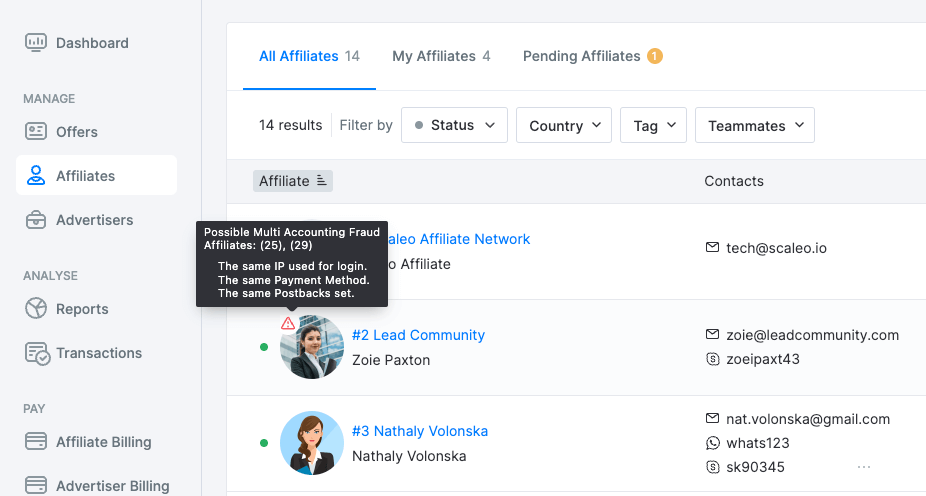Mobile ad fraud is becoming increasingly common in today’s digital world, and every day scammers are becoming more and more sophisticated by improving their dishonest techniques. To keep mobile fraud at bay, business owners need to constantly keep up with current fraud trends to avoid losing money on their mobile ad campaigns.
Some estimates estimate that up to 10% of mobile ad traffic may be fraudulent, meaning the advertiser is not getting what they paid for. This can cost companies millions of dollars in lost revenue and opportunities.
But there are some clever ways to detect and combat mobile ad fraud. The key is to stay one step ahead of the fraudsters by using technology, data analytics, and other methods to ensure that only legitimate traffic is delivered to your ads.
In this blog post, we will discuss the different types of mobile ad fraud and how you can identify them. We’ll also provide helpful tips on minimizing your risk of being a victim of mobile ad fraud.
What Is Mobile Ad Fraud?
Mobile ad fraud is a malicious activity that takes advantage of businesses by manipulating their traffic data to generate false impressions, clicks, and conversions. Think of it this way: You pay for an ad campaign and may see an increase in traffic, but the resulting conversions are not from real customers.

Mobile ad fraud comes in many forms. It can be “click injection,” whereby bots click on ads before legitimate users or even before the ads appear on a user’s device. It can also be “spoofing,” whereby spoofed or illegitimate traffic is generated to appear as if it’s coming from real customers.
What’s worse is that mobile ad scammers are always one step ahead of businesses because they have access to sophisticated tools and technologies that make it possible to generate fake impressions, clicks, and conversions in real-time while staying undetected. That’s why it’s essential for businesses to stay ahead of the curve when it comes to detecting and combating mobile ad fraud.
How Is Mobile Fraud Different From General Ad Fraud?
Mobile ad fraud can be particularly challenging to detect and combat. Mobile ad fraud is a more complex animal than general ad fraud—mostly because of the challenge in attributing the source of a particular fraudulent click.

To identify fraud, advertisers must track user behavior and define what is considered an anomaly or suspicious behavior. Mobile devices make this process difficult because users can rotate their screens, download multiple apps and access multiple websites from the same device — all within seconds. They can also delete or reset their devices without leaving any digital trace of the activity.
To successfully fight mobile ad fraud, you must first understand how it works:
- Cheaters use automated software programs (bots) to generate clicks on ads without real people ever seeing the ads.
- These bots emulate human behavior by mimicking mouse movements and installing apps on hundreds or thousands of devices quickly.
- Advertisers pay for these fraudulent clicks but don’t receive any benefit since no one actually views the ad.
- As a result, advertisers lose money and have poor visibility into accurately tracking user engagement data.
To protect yourself from mobile ad fraud, you must identify malicious traffic sources and block them from your campaigns. You should also implement anti-fraud technologies such as user authentication or device fingerprinting to ensure that only genuine users view your ads.
Different Types of Mobile Ad Fraud
The mobile app world has come a long way, but it’s still plagued by problems such as mobile ad fraud. Mobile ad fraud can be difficult to spot and even more difficult to combat without the right tools and strategies. Here are several of the most common types of mobile ad fraud and how to protect your business from them:
Click Injections
Click injections occur when an advertiser is charged for a fraudulent click that never occurred from a real user. These fraudulent clicks can add up quickly and cause serious damage to an advertiser’s budget. To prevent click injections, you should monitor your campaigns daily and ensure that all clicks are valid and from real users.
Click Farming
Click farming is when a fraudster uses fake accounts to generate false clicks on ads, causing advertisers to pay for those clicks even though they didn’t result in conversions or sales. To keep your business safe from click farming, you should use sophisticated software to monitor suspicious activity on your campaigns and quickly take action if necessary.
SDK Spoofing
SDK spoofing occurs when a scammer masquerades as someone else while downloading an app, usually with the intention of gaining some sort of reward or benefit. To prevent SDK spoofing, you should implement strict security measures such as two-factor authentication and identity verification. Additionally, you should ensure that all downloads are secure by verifying their source code before allowing them onto your platform.
Bundle ID Spoofing
Bundle ID spoofing happens when an app masquerades as another one using its bundle ID (the unique identifier given to each app). To protect against bundle ID spoofing, you should make sure that all.
How Mobile Ad Fraud Affects Advertisers
Mobile ad fraud is an ever-growing threat to advertisers, costing companies thousands – if not millions – of dollars yearly. As a result, it’s incredibly important for you to be aware of how mobile ad fraud can affect your business.
Difficult to Detect
Mobile ad fraud can be difficult to detect because it often operates undetected in the background until it’s too late. It’s also hard to detect because it often works by targeting users with “low quality” traffic, meaning they are highly unlikely to interact with or purchase anything. This makes it hard for advertisers to know if they are losing money due to fraudulent activities or ineffective campaigns.
High Cost
The cost of mobile ad fraud can be incredibly high. For example, the estimated cost of mobile ad fraud in 2019 was around $10 billion. Furthermore, these costs can easily accumulate over time as the fraudsters become more sophisticated and harder to detect.
As a result, you should take all necessary steps to combat mobile ad fraud or risk huge losses over time. Adopting an effective strategy is the key to ensuring that your campaigns are not falling victim to fraudulent activities and that the money you’re spending is being well spent.
What Does a Mobile Click Attribution Scenario Look Like?
Regarding mobile ad fraud, click attribution is a major concern. The click attribution scenario can begin when a malicious actor creates a series of bogus clicks that appear to originate from legitimate sources.
In this situation, advertisers can be deceived into believing they are getting more conversions than they actually are. Here’s what such a scenario might look like:
- The malicious actor installs bots on thousands of devices
- The bots generate thousands of fake clicks on advertisements from legitimate sources
- Advertisers are deceived into believing there are more conversions taking place than is actually the case
- Advertisers pay for the cost of all the fraudulent clicks, causing them to waste marketing dollars and receive fewer real leads or customers in return.
By understanding how these fraudulent scenarios work, advertisers are better equipped to detect and fight mobile ad fraud. With proper monitoring and preventive measures in place, advertisers can mitigate the risk of click attribution fraud and maximize the effectiveness of their ad campaigns.
Techniques to Detect & Combat Mobile Ad Fraud
Mobile ad fraud has been a growing problem for years, costing businesses millions of dollars in wasted ad spend. But with the right tools and techniques, you can detect and prevent fraud before it drains your bottom line.
Unit-level Analysis
The unit-level analysis allows you to track each individual user’s journey from installation to conversion. By taking a closer look at the behavior of these users, you can identify anomalies or unusual patterns that may indicate fraudulent activity.
Real-time Reporting
Real-time reporting capabilities make it easier to spot any discrepancies in your data. If you can keep a close eye on the analytics of your campaign, any suspicious behavior will be more likely to be caught quickly and addressed appropriately. This is particularly beneficial if you’re running many campaigns simultaneously, as it will help keep all your data accurate.
Fraud Detection Services
Third-party fraud detection services can help you identify and shut down fraudulent activities quickly and effectively. These services use sophisticated algorithms to detect suspicious patterns of user activity and alert advertisers as soon as possible. This allows you to address any issues before they cause too much damage to your campaigns.
Common Signs of Mobile Ad Fraud
Regarding mobile ad fraud, it’s important to identify any signs that may point to fraudulent activity or malicious bots. Here are some of the most common signs of mobile ad fraud:
Unusual Advertising Spend
If you suddenly see a dramatic increase in your advertising budget, it could be a sign of mobile ad fraud. Ad fraud can cause inflated advertising costs as bots and bad actors take advantage of your campaigns to drive up costs without providing any real value.
Clicks Coming from Suspicious Sources
If you notice a high number of clicks coming from suspicious sources, such as unknown apps or sites with questionable content, it could indicate mobile ad fraud. It’s important to look for patterns across different sources indicating click-stuffing or bot traffic.
Inaccurate Reporting Metrics
If you’re seeing discrepancies between your reporting metrics, such as click-through rates (CTRs) and conversion rates that don’t align with results from other sources, there may be fraudulent activity happening behind the scenes. Make sure to look at multiple data points and verify that everything makes sense before making any campaign changes.
How to Protect Your Campaigns Against Mobile Ad Fraud?
Mobile ad fraud is one of the biggest threats to your campaigns, and it’s important to stay vigilant and protect your business from potential losses. Fortunately, there are several strategies you can employ to prevent and detect fraudulent activity.
Use Technology to Identify Suspicious Activity
It can be difficult to monitor all of your campaigns for suspicious activity manually, but fortunately, various efficient tools are available.
Scaleo’s affiliate marketing software makes it easy to detect deceptive activity, such as non-human traffic and click injection, by providing detailed insights into the performance of campaigns in real time.

This data can help you quickly identify suspicious activity before it impacts your bottom line.
Secure Your Campaigns with Fraud Prevention Measures
In addition to using technology to identify suspicious activity, taking proactive steps to secure your campaigns against mobile ad fraud is important. Start by creating a comprehensive anti-fraud policy and ensure everyone involved in running the campaigns knows its rules and restrictions. Additionally, use strong measures like user authentication and bots detection software to detect robotic traffic or malicious campaign activities.
Safeguard your ad campaigns against fraud – switch to Scaleo.
One of the best ways to protect yourself against mobile ad fraud is to switch to Scaleo‘s verified system. Their platform offers advertisers real-time insights into their campaigns’ performance while providing access to powerful software designed to detect fraud and other malicious threats.
With Scaleo, you can:
- Protect against false app installs with advanced algorithms and machine learning models.
- Automatically track user behavior across all devices, ensuring users click on legitimate ads and see the correct creatives.
- Monitor discrepancies in impressions and clicks to detect any suspicious activity before it affects your campaign performance.
- Gain valuable insights into your campaign results with advanced data analytics and reporting tools.
- Keep your campaigns secure by blocking fraudulent sources from accessing your ads.
Scaleo’s verification system is one of the best solutions for combating mobile ad fraud and safeguarding your advertising budget from potential harm. With its powerful features, you can rest assured that you’re investing in a safe, reliable service that will always keep you one step ahead of any threat facing your ad campaigns.
Conclusion
Mobile ad fraud can be a major issue for businesses that rely on digital advertising, and it’s important to take the necessary steps to detect and combat it. As mobile ad fraud continues to advance and become more complex, it’s important for businesses to stay up-to-date on the latest fraud detection strategies and technologies.
Advanced analytics and attribution models, more sophisticated app business models, and fraud mitigation solutions can help keep your mobile advertising safe and secure. With proper mobile ad fraud detection and monitoring in place, businesses can protect their investments and increase ROI.
Last Updated on December 8, 2023







